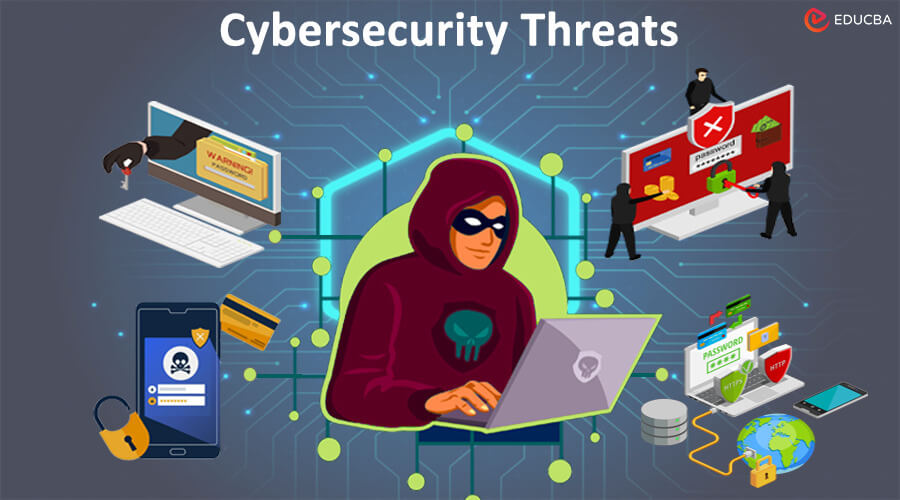Introduction to Cybersecurity Threats
In the ever-expanding digital landscape, the demand for strong cybersecurity measures is more critical than ever. With technical advancements, cybersecurity threats have become increasingly worldly, encompassing everything from malware and phishing attacks to devastating ransomware incidents capable of paralyzing entire systems. Navigating this complex terrain requires a deep understanding of cybersecurity fundamentals and implementing comprehensive defense strategies to safeguard against potential risks.

Rise of Cybersecurity Threats
A quick review of recent news underscores cybersecurity threats’ pervasive and escalating nature. Both individuals and organizations confront a broadening spectrum of online threats, ranging from extensive data breaches to complex ransomware attacks. The consequences of these breaches go beyond monetary losses, impacting trust and reputation.
Basics of Cybersecurity
Cybersecurity revolves around protecting digital assets and guaranteeing information confidentiality, integrity, and availability. Encryption is key in realizing these goals, offering a secure method for transmitting and storing sensitive data. A robust understanding of cybersecurity principles becomes essential when individuals and businesses are increasingly interconnected.
The Essence of Cyber Hygiene
Just as personal hygiene is crucial for physical health, cyber hygiene involves adopting sound practices to ensure a robust digital environment. A pivotal aspect of this is effective password management, emphasizing strong and distinctive passwords coupled with regular updates. Concurrently, maintaining awareness of software updates and implementing rigorous patch management protocols serves to seal potential vulnerabilities.
Two-factor authentication (2FA) stands out as a straightforward yet powerful tool, introducing an added layer of security. By directing users to provide two forms of identification, such as a unique code sent to a mobile device and a password, 2FA significantly diminishes the risk of unauthorized access.
Those seeking enhanced protection can consider incorporating an IPv4 proxy. These proxies act as intermediates between your device and the internet, adding security to your online activities.
Training and Awareness of Cybersecurity
Understanding that humans often represent the weakest link in the cybersecurity chain highlights the importance of education and awareness initiatives. Cybersecurity training provides individuals with the knowledge to recognize and prevent potential threats. A well-informed and alert user base is crucial in defending against social engineering tactics, such as phishing emails or deceptive websites.
Within organizations, employee awareness is particularly crucial. Cultivating a cybersecurity-focused culture and promoting best practices helps businesses minimize the risk of internal threats. Ensuring every team member maintains a secure digital environment is key to overall cybersecurity stability.
Cutting-edge Technologies in Cybersecurity
Cutting-edge technologies are emerging as powerful partners. Artificial Intelligence (AI) and Machine Learning (ML) lead, empowering proactive threat detection by analyzing patterns and anomalies within extensive datasets. The reinforcement of security is further elevated by behavioral analytics, which pinpoint deviations from typical user behavior.
Beyond its association with cryptocurrencies, blockchain technology is making significant steps in cybersecurity. Its decentralized and tamper-resistant attributes position it as a promising solution for ensuring secure transactions and safeguarding data.
Security Measures
A well-rounded approach is required to ensure thorough cybersecurity. Using firewalls and intrusion detection systems is essential in establishing network security as a critical defense against external threats. Simultaneously, endpoint security plays a vital role in safeguarding individual devices connected to a network, effectively preventing the increase of malware.
In the current era, where data is predominantly stored in the cloud, prioritizing cloud security is important. A secure cloud environment is achieved through robust encryption, rigid access controls, and regular audits, collectively providing a shield against unauthorized access to sensitive information.
Cybersecurity in the Corporate World
A robust cybersecurity policy is the primary defense in the corporate realm. This policy outlines the organization’s approach to protecting data, establishes protocols for employee conduct, and outlines plans for responding to incidents. Collaboration between IT and cybersecurity teams ensures a united and proactive defense strategy.
Planning for incident response is a critical aspect involving preparations for worst-case scenarios. With a well-coordinated plan, organizations can minimize the effect of a cyber attack and expedite recovery efforts. Regular drills and updates to the incident response plan maintain team flexibility and responsiveness to emerging threats.
Government and Global Initiatives
Governments and international organizations are key in establishing cybersecurity standards and fostering global cooperation. Collaborative efforts are essential to fight cybersecurity threats that exceed national borders. By sharing intelligence and working jointly to address exposures, the global community can enhance the resilience of digital infrastructure.
The Future of Cybersecurity
Looking ahead, the future of cybersecurity presents a dynamic mix of challenges and breakthroughs. The rise of unknown threats, such as those from quantum computing and the Internet of Things (IoT), underscores the need for adaptability and alert defenses. Embracing innovations in cybersecurity, such as leveraging machine learning for predictive analytics and incorporating automation into threat response, holds the key to outsmarting cybercriminals.
In summary, as we crack the complexities of cybersecurity, it becomes evident that a proactive and all-encompassing approach is indispensable for safeguarding our digital future. Prioritizing cyber hygiene, adopting state-of-the-art technologies, and fostering a culture of awareness empower individuals and organizations to construct the ultimate defense against the ever-shifting landscape of online threats. For an enhanced layer of protection in your online pursuits, consider integrating an ipv4 proxy, a valuable intermediary that bolsters the security of your internet activities.
Final Thoughts
Cybersecurity holds exceptional importance. Managing cybersecurity threats and understanding the fundamentals of cyber hygiene, alongside incorporating cutting-edge technologies, demands a thorough and proactive strategy. The pivotal elements include adopting advanced tools, promoting awareness, and enforcing robust security measures to protect our digital future. Governments, organizations, and individuals must collaborate, forging a resilient and secure online environment that stays ahead of emerging challenges and ensures a safer digital world.
Recommended Articles
If you found this article on Cybersecurity Threats useful, please check out the following recommendations:

